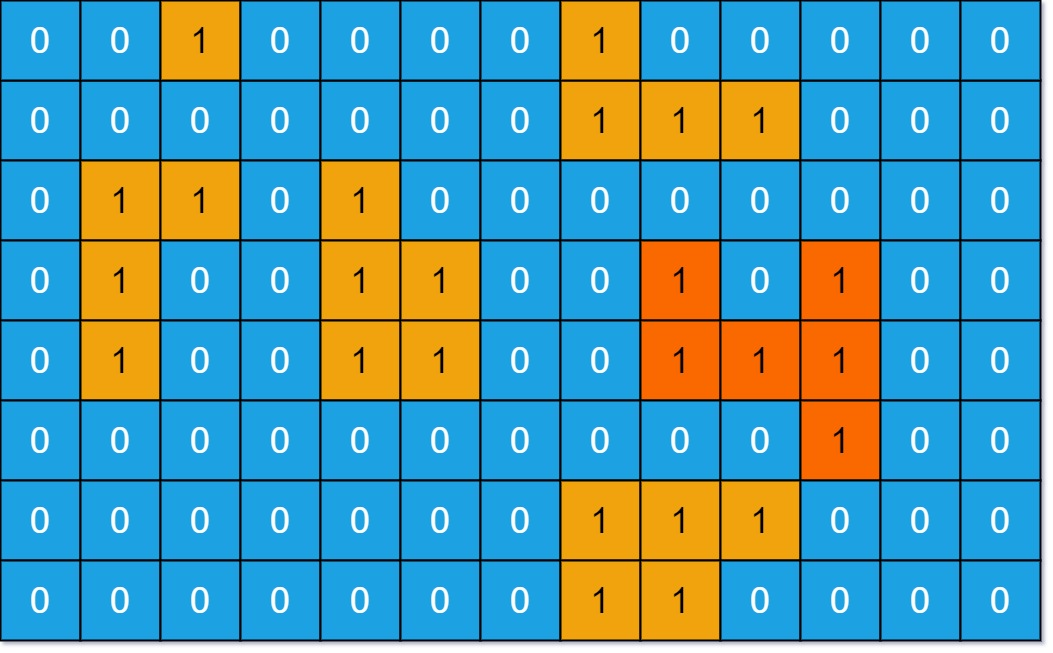Understand what the interviewer is asking for by using test cases and questions about the problem.
- Established a set (2-3) of test cases to verify their own solution later.
- Established a set (1-2) of edge cases to verify their solution handles complexities.
- Have fully understood the problem and have no clarifying questions.
- Have you verified any Time/Space Constraints for this problem?
HAPPY CASE
Input: grid = [
[0,0,1,0,0,0,0,1,0,0,0,0,0],
[0,0,0,0,0,0,0,1,1,1,0,0,0],
[0,1,1,0,1,0,0,0,0,0,0,0,0],
[0,1,0,0,1,1,0,0,1,0,1,0,0],
[0,1,0,0,1,1,0,0,1,1,1,0,0],
[0,0,0,0,0,0,0,0,0,0,1,0,0],
[0,0,0,0,0,0,0,1,1,1,0,0,0],
[0,0,0,0,0,0,0,1,1,0,0,0,0]
]
Output: 6
Explanation: The answer is not 11, because the island must be connected 4-directionally.
Input: grid = [[0,0,0,0,0,0,0,0]]
Output: 0
EDGE CASE
Input: grid = [[1]]
Output: 1
Match what this problem looks like to known categories of problems, e.g. Linked List or Dynamic Programming, and strategies or patterns in those categories.
For 2D-Array, common solution patterns include:
Plan the solution with appropriate visualizations and pseudocode.
General Idea: Perform a DFS for islands in the grid.
main function:
0) Write the helper dfs function
1) Initialize a variable to keep track of the largest islands
2) Iterate over the grid
3) If a '1' is seen: "explore" the island from this '1' using dfs and check size against previously recorded max area
4) Return the largest island size
helper dfs function:
0) Basecase: Out of bound or grid value is 0, return 0
1) Change the grid value to '0' to mark it as visited
2) Recursively check 4 neighbors from the current cell for more island cells (1's) and tack on 1 to account for this square⚠️ Common Mistakes
Implement the code to solve the algorithm.
class Solution:
def maxAreaOfIsland(self, grid: List[List[int]]) -> int:
# Write the helper dfs function
def helper(i: int,j:int) -> int:
# Basecase: Out of bound or grid value is 0, return 0
if i < 0 or i > len(grid) - 1 or j < 0 or j > len(grid[0]) - 1 or grid[i][j] == 0:
return 0
# Change the grid value to '0' to mark it as visited
grid[i][j] = 0
# Recursively check 4 neighbors from the current cell for more island cells (1's) and tack on 1 to account for this square
return helper(i+1, j) + helper(i-1, j) + helper(i, j+1) + helper(i, j-1) + 1
# Initialize a variable to keep track of the largest islands
maxArea = 0
# Iterate over the grid
for i in range(len(grid)):
for j in range(len(grid[0])):
# If a '1' is seen: "explore" the island from this '1' using dfs and check size against previously recorded max area
if grid[i][j] == 1:
maxArea = max(maxArea, helper(i,j))
# Return the largest island size
return maxAreaclass Solution {
public int maxAreaOfIsland(int[][] grid) {
// Initialize a variable to keep track of the largest islands
int max_area = 0;
// Iterate over the grid
for(int i = 0; i < grid.length; i++)
for(int j = 0; j < grid[0].length; j++)
// If a '1' is seen: "explore" the island from this '1' using dfs and check size against previously recorded max area
if(grid[i][j] == 1)max_area = Math.max(max_area, AreaOfIsland(grid, i, j));
// Return the largest island size
return max_area;
}
// helper dfs function
public int AreaOfIsland(int[][] grid, int i, int j){
// Basecase: Out of bound or grid value is 0, return 0
if( i >= 0 && i < grid.length && j >= 0 && j < grid[0].length && grid[i][j] == 1){
// Change the grid value to '0' to mark it as visited
grid[i][j] = 0;
// Recursively check 4 neighbors from the current cell for more island cells (1's) and tack on 1 to account for this square
return 1 + AreaOfIsland(grid, i+1, j) + AreaOfIsland(grid, i-1, j) + AreaOfIsland(grid, i, j-1) + AreaOfIsland(grid, i, j+1);
}
return 0;
}
}Review the code by running specific example(s) and recording values (watchlist) of your code's variables along the way.
Evaluate the performance of your algorithm and state any strong/weak or future potential work.
Assume N represents the number of rows in 2D-array.
Assume M represents the number of columns in 2D-array.
O(N * M) we need to view each item in the 2D-ArrayO(1), we only need to store the max area, excluding the recursive call stack. IF we include the recursive call stack, it will cost O(N*M) because a dfs call might be the entire matrix. 